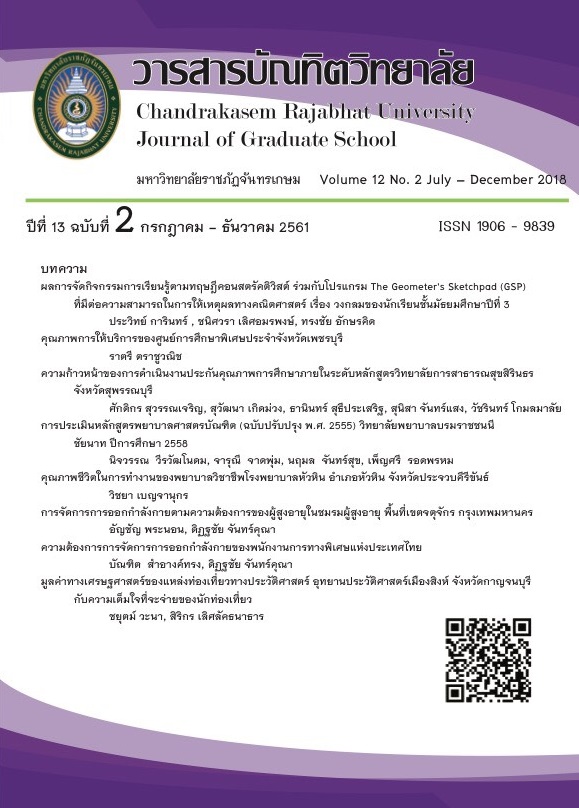การจัดการการออกกำลังกายตามความต้องการของผู้สูงอายุในชมรมผู้สูงอายุ พื้นที่เขตจตุจักร กรุงเทพมหานคร
Main Article Content
บทคัดย่อ
การวิจัยนี้มีวัตถุประสงค์เพื่อ (1) ศึกษาความต้องการการออกกำลังกายของผู้สูงอายุในชมรมผู้สูงอายุ พื้นที่เขตจตุจักร กรุงเทพมหานคร (2) เปรียบเทียบการจัดการการออกกำลังกายตามความต้องการของผู้สูงอายุในชมรมผู้สูงอายุ จำแนกตามข้อมูลส่วนบุคคล และประเภทของโรคในผู้สูงอายุ การวิจัยนี้เป็นการวิจัยเชิงปริมาณ ประชากรที่ใช้ในการศึกษานี้ คือ ผู้สูงอายุในชมรมผู้สูงอายุ พื้นที่เขตจตุจักร กรุงเทพมหานคร จำนวน 1,256 คน กลุ่มตัวอย่าง จำนวน 303 คน ได้จากการสุ่มแบบง่าย เครื่องมือที่ใช้ในการวิจัยคือ แบบสอบถาม ที่มีค่าความตรง และค่าความเชื่อมั่นเท่ากับ 0.86 และ 0.92 ตามลำดับ สถิติที่ใช้ในการวิเคราะห์ข้อมูล ได้แก่ ร้อยละ ค่าเฉลี่ย ส่วนเบี่ยงเบนมาตรฐาน การทดสอบค่าที การทดสอบค่าเอฟ การวิเคราะห์ความแปรปรวนทางเดียว ร่วมกับวิธีการเปรียบเทียบความแตกต่างรายคู่ กำหนดนัยสำคัญทางสถิติที่ระดับ 0.05
ผลการวิจัยพบว่า (1) ความต้องการการออกกำลังกายของผู้สูงอายุในชมรมผู้สูงอายุ มีค่าเฉลี่ยอยู่ในระดับมากที่สุด ทั้ง 4 ด้าน และเรียงลำดับค่าเฉลี่ยรายด้านจากมากไปหาน้อยได้ดังนี้ ด้านบุคลากร มีค่าเฉลี่ย 4.87 ด้านกระบวนการในการจัดกิจกรรมการออกกำลังกาย มีค่าเฉลี่ย 4.77 ด้านสถานที่ วัสดุอุปกรณ์ และสิ่งอำนวยความสะดวก มีค่าเฉลี่ย 4.69 และด้านการบริหารจัดการ มีค่าเฉลี่ย 4.54 และ (2) การเปรียบเทียบระดับการจัดการการออกกำลังกายตามความต้องการของผู้สูงอายุในชมรมผู้สูงอายุ พบว่า ผู้สูงอายุที่มี่รายได้เฉลี่ยต่อเดือนต่างกัน มีความต้องการการจัดการการออกกำลังกายแตกต่างกันอย่างมีนัยสำคัญทางสถิติที่ระดับ 0.05 จำนวน 4 ด้าน ได้แก่ ด้านบริหารจัดการ ด้านบุคลากร ด้านสถานที่ วัสดุอุปกรณ์ และสิ่งอำนวยความสะดวก ด้านกระบวนการในการจัดกิจกรรมการออกกำลังกาย และผู้สูงอายุที่มีเพศ อายุ ประเภทของโรคในผู้สูงอายุต่างกัน มีความต้องการการจัดการการออกกำลังกายแตกต่างกันอย่างมีนัยสำคัญทางสถิติที่ระดับ 0.05 จำนวน 2 ด้าน ได้แก่ ด้านบริหารจัดการ กับด้านสถานที่ วัสดุอุปกรณ์ และสิ่งอำนวยความสะดวก
Article Details
เอกสารอ้างอิง
2. นิศา ชูโต. (2525). คนชราไทย. กรงเทพฯ: จุฬาลงกรณ์มหาวิทยาลัย.
3. ปณิตา ชะบำรุง. (2549). ปัจจัยที่ส่งผลกระทบต่อพฤติกรรมการออกกำลังกายของผู้สูงอายุในจังหวัดพระนครศรีอยุธยา (วิทยานิพนธ์ศิลปศาสตรมหาบัณฑิต), มหาวิทยาลัยราชภัฏพระนครศรีอยุธยา.
4. กระทรวงการพัฒนาสังคมและความมั่นคงของมนุษย์. (2546). พระราชบัญญัติผู้สูงอายุ พ.ศ. 2546. สืบค้น 7 พฤศจิกายน 2560, จาก http://www.oppo.opp.go.th/pages/law/law09.html
5. พิทักษ์พงศ์ ปันต๊ะ และดาว เวียงคำ. (2554). ความสัมพันธ์ระหว่างปัจจัยส่วนบุคคล การรับรู้ประโยชน์ ของการออกกำลังกายและการรับรู้อุปสรรคของการออกกำลังกายกับพฤติกรรมการออกกำลังกายของผู้สูงอายุในจังหวัดพะเยา. วารสารวิจัยทางวิทยาศาสตร์สุขภาพ, 5(1), 7 - 16.
6. มูลนิธิพัฒนางานผู้สูงอายุ. (2559). สถานการณ์ผู้สูงอายุในประเทศไทย (ด้านประชากร). สืบค้น 7 พฤศจิกายน 2560, จาก https://fopdev.or.th/สถานการณ์ผู้สูงอายุ/.
7. มูลนิธิสถาบันวิจัยและพัฒนาผู้สูงอายุไทย. (2553). รายงานสถานการณ์ผู้สูงอายุไทย พ.ศ. 2553. สืบค้น 7 พฤศจิกายน 2560, จาก http://www.thaitgri.org/index.php?option=com_content&view=article&id=218:2353&catid=50:2011.
8. รุ่งนภา แจ้งรุ่งเรือง. (2550). ความต้องการในการพัฒนาตนเองของบุคลากรองค์กรปกครองส่วนท้องถิ่นในเขตจังหวัดระยอง (รายงานการศึกษาอิสระปริญญารัฐประศาสนศาสตรมหาบัณฑิต) วิทยาลัยการปกครองท้องถิ่น มหาวิทยาลัยขอนแก่น.
9. สังคมสูงวัย & วิกฤติสโลว์ไลฟ์. (1 พฤษภาคม 2560). Way, สืบค้น 7 พฤศจิกายน 2560, จาก https://waymagazine.org/aging_society/.
10. สำนักพัฒนาสังคม กรุงเทพมหานคร. (2559). ข้อมูลชมรมผู้สูงอายุในพื้นที่ 50 เขตของกรุงเทพมหานคร. สืบค้น 7 พฤศจิกายน 2560, จาก http://bangkok.go.th/social/.
11. สุรางค์รัตน์ วศินารมณ์. (2540). สวัสดิการในองค์การ แนวคิด และวิธีการบริหาร. กรุงเทพฯ: เม็ดทราย พริ้นติ้ง.
12. Hainmann and Scott. (1970). Management in the Modern Organization. Carifornia: Houghton Miffin.
13. Longenecker, Justin G. and Charles D. Pringles. (1981). Management. (5th ed.). Columbus, Charles E. Merrill Publishing Company.
14. Maslow, Abraham. (1970). Motivation and Personnality. New York: Harper and Row Publishers.
15.Orem, D. E. (1985). Nursing Concepts of Practice. New York: Mc Graw - Hill.


